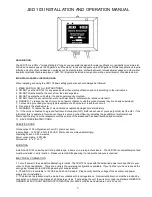
Both modes transfer the same amount of channels (32), but the 96k
frame mode has the advantage, that the receiver can distinguish the
SMUX/1 and SMUX/2 modes, so it can switch automatically between
48kHz and 96kHz for example. 96k frame is the preferred setting if the
receiver can recognize it.
MADI short frame (On = 56 Ch, Off = 64 Ch format)
The most common MADI configuration is 64 channels (SMUX/2: 32
channels, SMUX/4: 16 channels). This uses the full bandwidth of the
MADI interface. When enabling the short frame option, the device will
send only 56 (SMUX/2: 28 channels, SMUX/4: 14 channels) instead of
64 channels. This option corresponds to an older standard, where the
bandwidth of the missing eight channels is used to change the speed of
the MADI signal within some percent up or down.
Delay Compensation
When connecting several PULSE16 DX units in daisy-chain the MADI
data will be routed thru the first unit to the second unit and so on. This
results in a small delay of the data on the second, third and fourth unit.
To compensate this delay you have to tell the PULSE16 DX which order
it is inside the MADI chain:
•
Single: only one unit connected.
•
1 of 4: first device in the MADI chain
•
2 of 4: second device in the MADI chain
•
3 of 4: third device in the MADI chain
•
4 of 4: fourth device in the MADI chain
MIDI control
Here you can set from which port the PULSE16 DX should receive
remote commands:
•
From the 5-pin-MIDI input only
•
From the MIDI-over-MADI input only.
•
From both sources.
Dante control messages are being sent in parallel to the MIDI port.














































